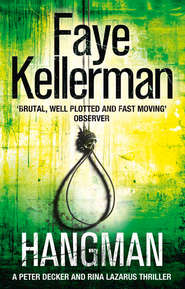По всем вопросам обращайтесь на: info@litportal.ru
(©) 2003-2024.
✖
Peter Decker 2-Book Thriller Collection: Blindman’s Bluff, Hangman
Автор
Год написания книги
2019
Настройки чтения
Размер шрифта
Высота строк
Поля
Decker sat up. As he underlined the sentence, he immediately thought of Milfred Connors, the accused account executive who was caught embezzling by Neptune Brady. Was there a connection between Connors and Mace Kaffey?
It appeared that the brothers were involved in litigation that lasted several years, and neither Mace nor Grant thought it important enough to mention. Maybe that was because things eventually resolved. Mace remained in the business, but no longer sat on the board of directors. He was given a new title of executive VP of East Coast Operations, that sector eventually operated by Guy’s younger son, Grant. The rest of the summary dealt with the Greenridge Project, some analysts implying that it was Mace’s last shot to redeem himself with the company.
If that was the case, Mace seemed to be on shaky grounds. From the start, Greenridge was plagued with problems. The location demanded several dozen environmental impact reports that resulted in many changes of plans. Eventually the project found a design that was approved, but the delays and the added costs coupled with the downturn in the economy and funding deficits had swelled the original budget by a factor of five. There was a quote from the Journal of News and Business about the Greenridge Project:
Isn’t it time that Guy Kaffey do what he should have done years ago? Pull the plug on his dead-weight brother, Mace? Filial loyalty is an admirable trait, but a company—even a privately owned company—cannot be run on sentiment.
If Mace went down with the Greenridge Project, what about Grant? Wasn’t he part of it as well? If there were problems, why would Mace be the goat and not Grant?
The last paragraph of the synopsis was “An Insider’s Look at Guy Kaffey” from PropertiesInc.com that was more about Guy the man than Guy the businessman. His friends spoke about Guy’s exuberance: his foes described him as a hothead. He was well known for his outbursts, and his moods could turn at a moment’s notice. Guy was described as bold and daring, but he was also detail oriented and meticulous.
Decker wondered how much of his outbursts had to do with his possible bipolar disorder. Did he sue his brother in a manic fit or was there just cause? Certainly it would seem that the charges were unjustified if Guy agreed to hire Mace back into the company.
Decker put Guy’s summary down and moved on to Mace. There wasn’t anything too illuminating in the summary. Mace was a high school dropout. He worked for his brother. He moved out to sunny Cal with his wife, Carol, to work with Guy in Kaffey Industries. He had a son named Sean. Everything seemed to be hunky-dory with Mace until the embezzlement charges were leveled against him.
This time Lee Wang got specific. Mace Kaffey was accused of stealing five million dollars. Decker couldn’t help it; he whistled out loud. There weren’t any specifics on how the embezzling was done except to say that Guy got wind of the discrepancy during a routine inventory check and one thing led to another until he was forced to confront his brother. Mace vehemently denied the charges and even offered to hire a private detective to find out who the real culprit was. But Guy had his own sources.
The battle of the brothers lasted several years and during that time, the company’s stock plummeted. The charges and countercharges seemed equally matched until Guy prevailed. A month later, the case was settled. Guy retained the title of CEO, Gil Kaffey moved into the president spot, Grant was named in charge of East Coast operations, and Mace was shipped to upstate New York with a VP after his name.
Decker was confused. If Mace really was guilty of such blatant embezzlement, why would Guy retain him? Did Milfred Connors frame Mace for his theft? Or just as likely, did he take the fall for Mace’s stealing? Perhaps the two of them schemed together. And what happened to the money? Was it ever at least partially recovered?
He wrote notes in the margin and moved on to the next generation—Gil, thirty-two; Grant, thirty; and Sean, twenty-eight. Grant was the only married man; his wife was named Brynn and there was one child—a toddler boy. Gil was gay; Sean was still unmarried. All three boys had graduated from Wharton at the University of Pennsylvania. Gil and Grant were immediately sucked into Kaffey Industries, but Sean struck out on his own. He had just graduated from Harvard Law and was doing case law and business law at a small university in the Northeast.
Definitely the smart one, Decker thought.
The last bio had to do with Gilliam Kaffey née Jill Sultie. She grew up as trailer trash. Somewhere along the way, she blossomed from a bony adolescent into a beautiful woman and got a job as a Las Vegas showgirl when she was just eighteen. A year later, she was sporting a rock on her finger courtesy of her first husband, Renault Anderson, and buying her mother, Erlene, her very first house with a foundation instead of wheels.
For a while, it seemed as if Jill had found the golden goose and she was living on twenty-four-karat omelets. Then life came crashing down, mainly due to Renault’s philandering. The divorce was said to be amicable. She met Guy during a low period of her life. They clicked instantly, and like they say in the movies, the rest is history.
Rubbing his eyes, Decker checked the wall clock and realized he had been reading for over an hour. He got up and stretched, then peered through the glass walls of his office. He spotted Wang typing away on the computer and opened the door.
“Lee?” Wang looked up. “Do you have a moment?”
“Sure.”
Decker told him to come inside and have a seat. “I finished your synopses. The family history reads like a soap opera script.”
“Yeah, could you make up a name like Renault Anderson?”
“That’s one for the books. I have a couple of questions about Mace Kaffey. There are these allegations of embezzlement against him, and then all of a sudden, the lawsuit’s settled.”
“Yeah, weird, huh?”
“More than weird. There had to be a backstory. I’m wondering if the accusations were related to the embezzlement charges leveled against Milfred Connors.”
“Yeah, I thought about that, too. Maybe that’s why the lawsuit was settled. Maybe Connors framed Mace and when he was made, Guy dropped the suit.”
“But then why would Mace have been demoted if he were innocent? And if Mace wasn’t innocent, why would Guy keep his cheating brother in any aspect of the business?”
“Maybe that was part of the settlement.”
“But from talking to Mace and Grant, Mace is heavily involved in the multimillion-dollar Greenridge Project. Why would Guy keep him in something so costly, especially if he thought that Mace was embezzling?”
“Maybe it was Grant who was embezzling, Mace took the fall for him, and Guy put Mace back east to keep an eye on Grant.”
Decker frowned. “Sort of a convoluted theory, but I’m open to anything. The Greenridge Project sounds like a big boondoggle. You wrote Guy up as a hard-nosed business type. If something was flushing money down the toilet, I don’t think Guy would hesitate to pull the plug.”
“On Mace, for sure, but maybe not on Grant. Maybe the old man had a soft spot for his sons. I found a year-old interview with Mace’s son, Sean, on Kaffey Industries. Sean said a lot of things, but one particular thing stuck in my mind. Sean said and I quote, ‘My uncle has more than a soft spot for his sons. It’s actually a blind spot.’”
11 (#ulink_ef8eb40b-d56e-5427-832f-3803ccb7c825)
They stood twenty abreast, police officers interspersed with volunteers trained in this tedious aspect of protocol. All of them had a whistle around their neck and held a map in their hands. They were waiting for Wynona Pratt to give the signal—one long toot to begin and two short toots to stop. The detective had come down to the ranch several hours earlier to scope out Coyote Ranch. The vast acreage beyond the buildings and the riding corral was hard-packed terrain pocked with clumps of grasses, thorny briar, silver-leaf shrubs, purple sage, wild daisies, yellow dill weed, and chaparral, the land stretching out until it collided with the foothills. There the fauna climbed and joined forces with fragrant pines, eucalyptus, and stunted California oak, greening the mountainsides and shading the trails that cut through them.
Adjusting her sun hat, Wynona peered through UV-protected spectacles at the map in front of her. She had divided it into five sectors, and with a little luck they’d finish it today. She had dressed comfortably—cargo pants to hold extra items, a cotton T-shirt, and sneakers. Her fair skin necessitated that she slather on sunscreen, and she hoped sun damage would be limited to freckles. She held her hand aloft, then brought it down with a snap along with a long, shrill whistle. The line walked forward in a unit, eyes on the ground in front of them. The list of what they were looking for was long and varied—footprints, tire tracks, drag marks, bits of clothing, popped buttons, bloodstains, food and food wrappers—any kind of evidence that pointed to human contact with nature.
The morning was cool but warming quickly. The sun was unmasked in a clear sky, reflective against the red stone. The air was filled with spring insects that had hatched with the heat—gnats, flies, bees, wasps. Crows cawed lazily as a hawk circled high above, looking for its breakfast.
The search of the first sector lasted just a little over two hours with meager results—a scattering of various fibers and metals including pop-tops and bottle caps. More numerous were horse prints and desiccated horse shit. A volunteer found a shoe impression that was clear enough to merit an alginate cast. The rest of the search was slim pickings. They moved on to sector two and by the time that space had been combed, the crew was hot and tired and needed sustenance. During the twenty-minute allotment they had for lunch break, Wynona called Marge.
“How’s it going inside?”
Marge said, “TMI.” Too much information. “Everywhere we turn, we have blood or tissue or a footprint or hair or a bullet casing.”
“If you have TMI, we’re suffering from TLI.”
“How far along are you?”
“We’re about to start with sector three. I’ll call you in a couple of hours.”
The group resumed their hunt at two in the afternoon. At 4:14, someone sounded two quick toots and the row of searchers lurched to a stop. The whistle blower was a young police officer in his twenties named Kyle Groger. He called Wynona over.
“Take a look at that area, Detective, about twenty feet from here.” He pointed to the spot. “It looks odd.”
Wynona took off her sunglasses and stared at the ground, her eyes traveling forward until she saw what had caught Groger’s attention. From a distance, the patch was indistinguishable from the surrounding area. Same color ground, same types of foliage, same pebble-strewn earth. Yet it looked distinctly different.
First of all, the eight-by-eight plot of ground had sunk into the earth, lower than the surrounding terrain by about an inch or so. There were also two big boulders on top. The environs supported many big rocks, but two in such close proximity was a little odd. Also the foliage on the plot wasn’t faring well: around a dozen drooping sage plants, straw yellow grasses, and scattered daisies with limp petals. It could be that these particular plants had wilted in the heat except that the flora that surrounded the area was erect and hydrated.
She walked over to the spot and pulled up a sage plant. It gave way with relative ease, and the roots were soft and dried out. She dropped to a stoop and dipped a finger in the ground. The soil was compact, and not easy to dig into. It was then she noticed that the earth had been scored by hundreds of little lines running in all directions. She stared at them closely. It was as if someone was hitting the ground, tamping it down with a shovel over and over and over.
A homemade grave?
She stood up and searched for shoe or tire prints, but found nothing. She called Marge on her cell phone and asked her how it was going inside.
“Still slogging through the muck. What’s going on?”
“I think there’s something here that you should see.”
While waiting for extra shovels and buckets, Marge assigned one of the CSI techs the official role of police photographer.











